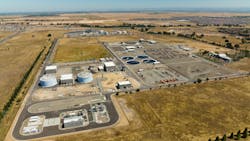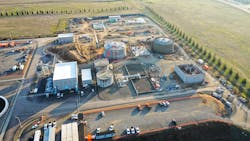Plant Profile: Pleasant Grove Wastewater Treatment Plant
Just outside Sacramento, California, the City of Roseville is putting its wastewater treatment to use to generate fuel for its solid wastes truck fleet.
The city of Roseville has two regional wastewater treatment plants — Pleasant Grove wastewater treatment plant (WWTP) and Dry Creek WWTP — and it also operates the solid wastes, drinking water and electricity utilities for Roseville, Rocklin, Loomis and parts of Placer County. These regional plants service nearly 200,000 residents with approximately 17 million gallons per day (mgd) of dry weather flow.
In 2016 planning began by the wastewater department to expand the Pleasant Grove WWTP to include biogas capture and, at the same time, the solid wastes department was looking at renewable natural gas to fuel its fleet of trucks. These visions also played into a larger organizational goal related to climate change and carbon footprint.
Perhaps more importantly, the return on investment — 20 years according to the city’s planning — will curb costs in the long run while also creating a revenue source for the wastewater utility as the city builds out a co-digestion program to capture more gas.
How the system works
As part of the expansion, the Pleasant Grove WWTP constructed a receiving facility to accept high-strength organic wastes — fats, oils and gas in particular — for its co-digestion program to generate the renewable natural gas (RNG) for the truck fuel.
The more of this waste, the better, as it helps to generate more biogas from the anaerobic digesters, which were also part of the expansion. The installed system also uses four microturbine cogeneration units to provide the heat needed in the anaerobic digestion process and to power the gas conversion process. Bryan Buchannan, wastewater utility manager for the City of Roseville, said the microturbines presented the biggest challenge for operators upon completion.
Brown and Caldwell designed the system for this expansion and in a press release about the project estimated 12,000 tons of high-strength wastes would be diverted from the landfill and instead converted to fuel for the city’s refuse trucks each year. Whittington said the waste-to-energy process has a couple of beneficial outcomes for the utility overall.
“It does two things. It gives us a stable price from a collection aspect for the waste collection vehicles,” Whittington said, “and then it provides the wastewater utility with a better revenue source than just converting that to electricity, so it’s like a win-win situation for the utilities.”
That truck fleet amounts to 47 trucks and, as of May 2023, the fleet uses renewable natural gas for fuel, which eliminated diesel consumption. Brown and Caldwell estimated the greenhouse gas emission reduction to be 7,000 metric tons of CO2 equivalents per year.
General plant flow
The water enters the plant from a 96-inch-diameter main before it is pumped into a grit chamber, which is at the highest point of the facility. The remainder of the treatment is fed by gravity.
Flow then continues to secondary clarifiers to settle out more solids, a tertiary treatment process and finally through ultraviolet disinfection. At this point, the water is either discharged into the Pleasant Grove Creek or it is used as recycled water, primarily for irrigation and landscaping.
“We have four golf courses and then we have parks and schools, so it’s all land irrigation,” said Buchannan. “We do have one industrial customer, which is just north of the Pleasant Grove treatment plant, and they use it for cooling water in their process.”
Funding & project challenges
Had the utilities involved — wastewater and trash collection — not been under the same umbrella within the city, Whittington said the project would have been more difficult. Creating the nexus needed for with a private refuse collection utility, for example, would require more negotiations and work to reach a unified vision.
The Roseville waste-to-energy project was funded with grant funds from the local air district and state level grants — the California Energy Commission being a primary grant issuer — as well as bonds. Buchannan said the city used development fees to fund the majority of the project.
“This project was part of an expansion project and our capacity projects and expansion projects are all funded through our development fund,” Buchannan said. “We don’t use current customer funds to fund these kinds of projects.”
Whittington noted the long term pay off in the cost of the fuel, Renewable Identification Number credits from the U.S. EPA, and California’s Low Carbon Fuel Standard credits also play into reducing the overall project cost.
Adding to the challenges with the project, Buchannan said the plant had to remain in operation during construction. The primary challenge, however, came after construction was complete and operators needed to be trained on the new equipment which serves the two aforementioned purposes: gas produced for fuel and electricity for the facility.
Regulations & the future
Whittington and Buchannan noted recent regulatory changes in California are pushing for greater electrification of municipal vehicles, posing a challenge for the utility’s investment into RNG as a fuel source.
Buchannan said that, despite the regulatory hurdle, the city of Roseville sees a new horizon for RNG opportunities.
“As we move into the future, the challenges on the regulatory side of things where we may see electrification of the refuse fleet, we may need to find alternative outlets for our gas,” Buchannan said. “There are other opportunities, so we’re definitely going to be looking into that in the future.”
Location: Roseville, California
Size: 12 mgd dry weather flow
Equipment: grit chambers, oxidation ditches, aeration, anaerobic digestion, clarification, tertiary treatment, ultraviolet disinfection, biogas capture
About the Author
Bob Crossen
Bob Crossen is the vice president of content strategy for the Water and Energy Groups of Endeavor Business Media, a division of EndeavorB2B. EB2B publishes WaterWorld, Wastewater Digest and Stormwater Solutions in its water portfolio and publishes Oil & Gas Journal, Offshore Magazine, T&D World, EnergyTech and Microgrid Knowledge in its energy portfolio. Crossen graduated from Illinois State University in Dec. 2011 with a Bachelor of Arts in German and a Bachelor of Arts in Journalism. He worked for Campbell Publications, a weekly newspaper company in rural Illinois outside St. Louis for four years as a reporter and regional editor. Crossen can be reached at [email protected].




